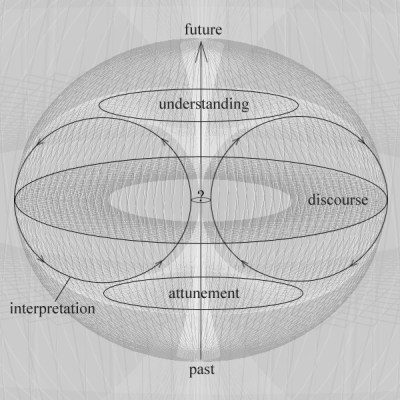



































relational inquiry regarding meaning » value
 In Being and Time, Division I, Chapter V: "Being-in As Such," Heidegger presents existential hermeneutics involving Dasein interpretting the open-ended question at its core—viz., "what does it mean to be?" Dasein interprets what it means to be through active engagement with the world (as Being-in-the-world). This process is dialogical. First, self and world are in dialogue as Dasein is open to the world and actively engaged therewith. Specifically, a particular Dasein interprets what it means to be by engaging with the contents of its foregrounded experience, relating these contents to its background familiarity with its world overall. The hermeneutic circle traces this foreground/background dialogue. Each time new information and new experiences are encounted in the foregound, Dasein's background is updated, thus changing its "frame of reference" for understanding the next encounter.
In Being and Time, Division I, Chapter V: "Being-in As Such," Heidegger presents existential hermeneutics involving Dasein interpretting the open-ended question at its core—viz., "what does it mean to be?" Dasein interprets what it means to be through active engagement with the world (as Being-in-the-world). This process is dialogical. First, self and world are in dialogue as Dasein is open to the world and actively engaged therewith. Specifically, a particular Dasein interprets what it means to be by engaging with the contents of its foregrounded experience, relating these contents to its background familiarity with its world overall. The hermeneutic circle traces this foreground/background dialogue. Each time new information and new experiences are encounted in the foregound, Dasein's background is updated, thus changing its "frame of reference" for understanding the next encounter.
The constitutive elements of Being-in as such (the existential constitution of Dasein's "there") include Dasein's attunement (Befindlichkeit), understanding, and discourse. These roughly map on to past, future, and present, respectively. I have borrowed heavily from Heidegger's thoughts here when conceiving of the A-phase. I in fact interpret Heidegger's existential hermeneutics graphically by overlaying his ideas on the torus structure. The bottom opening is attunement, the top opening understanding, and the horizonal disk in the middle is discourse. The "donut hole" is the open ended question at the core of Dasein asking, "what does it mean to be?"
—see Heidegger, M. (1927) Being and time [J. Macquarrie & E. Robinson, trans. Harper & Row 1962], esp. I.5: "Being-In As Such"
There are clear parallels between the ideas explored in the A-phase and pragmatism. According to pragmatism ideas are rules for action, actions have consequences, and consequences matter. So, ideas matter. Moreover, the way ideas matter determines the meaning of those ideas in the first place. The mind is a tool that helps us adapt to ever-changing circumstances, and the meanings of the contents of our minds (our ideas/beliefs) depend on the particular way those contents help us adapt.
_symbol & metaphor
• element: air
• Kabbalah: Tree of Life: Mythologies, mystical traditions, and theologies, with their use of language rich in symbolism, are particularly well equipped to speak to our psyches' subjective experience of truth. One such tradition from Western occultism is the Jewish mystic tradition of Kabbalah. Much of Kabbalistic philosophy is contained in a symbolic diagram called the Tree of Life which bears some resemblance to this Project's l'arbre de rien. These resemblances and possible correspondences may be well worth exploring.
• magick: sword (destruction/analysis)
